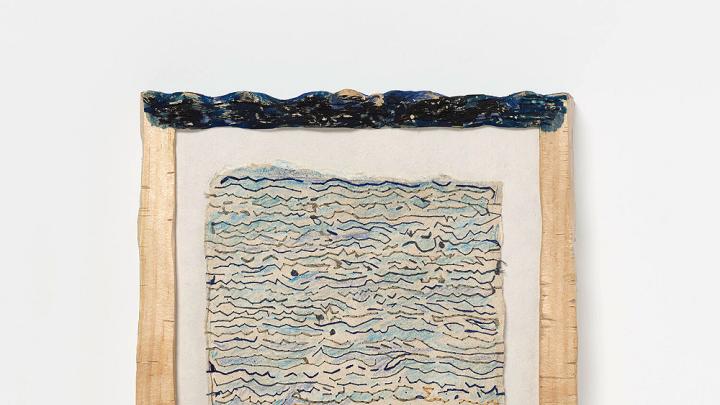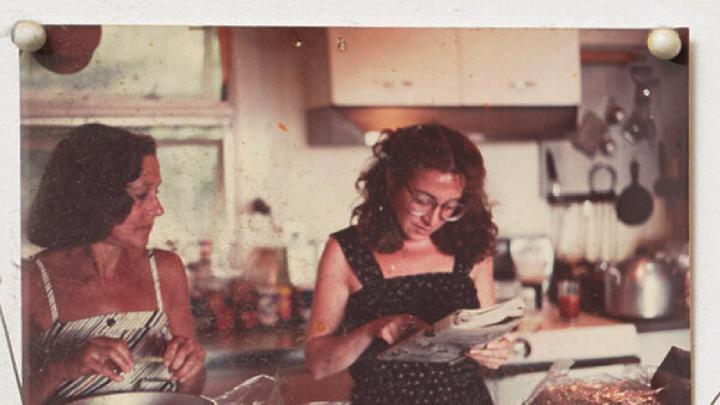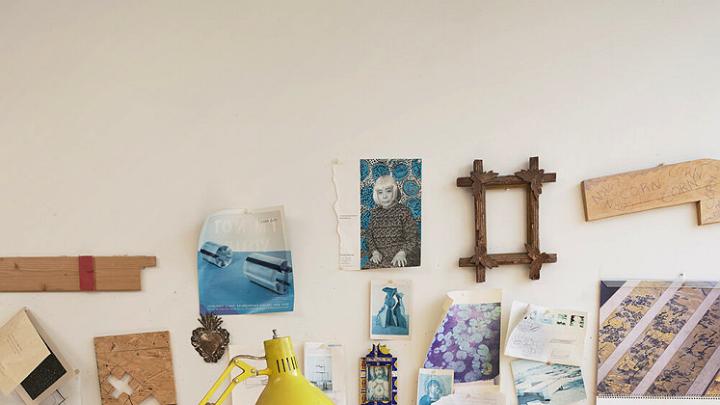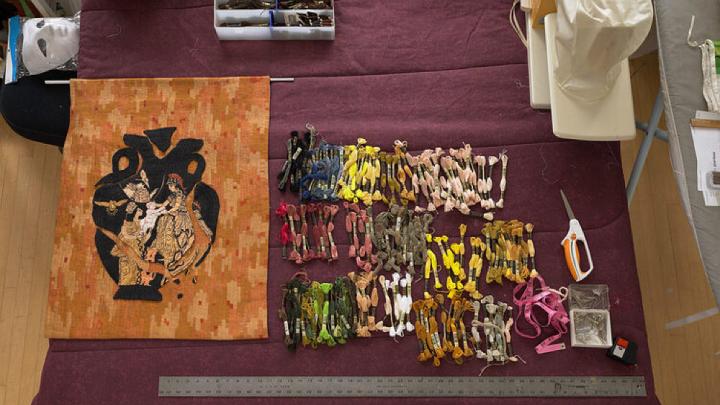“It wouldn’t be my life if I didn’t talk to Marilyn every day,” said artist Jill Slosburg-Ackerman. She was speaking during a Zoom discussion last week that marked the opening of the Radcliffe Institute’s first-ever online-only exhibition, “Accompanied: The Artworks of Marilyn Pappas and Jill Slosburg-Ackerman.” In photographs, recorded interviews, and interpretive essays, the show explores the two women’s decades-long bodies of work. Slosburg-Ackerman uses discarded furniture, sawdust, and wood scraps to build sculptures, installations, and drawings that recall the pragmatism and pioneer history of her native Omaha, Nebraska. Pappas creates large-scale textile works inspired by classical vases and sculptures of women and goddesses, which she has visited on numerous trips to the Mediterranean. Often broken and faded, the female bodies in these ancient artifacts still radiate strength. One recent installation series is called Nevertheless She Persisted, a title taken from the 2017 remark aimed at Senator Elizabeth Warren by Senate majority leader Mitch McConnell, which then became a feminist rallying cry.
But the Radcliffe exhibit is as much about the artists’ creative friendship as it is about their creative output—and the solidarity of two women artists carving out time and space for themselves and for each other during a period when women often struggled to find much of either. “Friendship offers a model of being-with-the-other, a mode of giving and receiving, that seems unbound by ideology or common thought,” writes Los Angeles-based writer Anya Ventura in an essay that accompanies the exhibit. “Friendship resists the totalizing forces of the group. Unlike family and marriage, friendship is not regulated by law, property, or blood. Friendship requires no certificates, licenses, paperwork, or formal tests—it remains, enticingly, beyond the purview of officialdom. We choose our friends and claim them in our private ways. And if the beat of the nuclear family is set to a uniform pace, friendship maintains a far stranger tempo.”
Slosburg-Ackerman and Pappas met during the 1970s at the Massachusetts College of Art, where they were faculty members, and both received separate Bunting fellowships at Radcliffe during the 1980s. (The fellowship was founded in 1960, and the exhibit in part celebrates its sixtieth anniversary.) In 1989, they were among the co-founders of the Brickbottom Artists Association and Gallery in Somerville; they have had studios beside each other ever since, with a shared kitchen and bathroom. The Radcliffe exhibit is anchored in part by a pair of interactive panoramic images showing the inside of each artist’s studio. Meg Rotzel, the exhibition’s curator, and friend for many years of both women, recalls visiting Slosburg-Ackerman’s studio early on in their friendship and coming across a towel labeled with Pappas’s name. “It was like, wait a second—there’s someone else here, too. That’s when I realized about Marilyn, and I was so curious about her,” Rotzel says, noting how the women have seen each other through decades of life—marriages, widowhood, parenthood, careers—and art. “This is where their artistic lives unfolded, next to each other.”
During the isolation of the last six months, the women’s closeness has endured, even strengthened. Pappas, who will turn 90 at the end of this year and is older than Slosburg-Ackerman, described how they have arranged (with the assent of her doctor) to keep seeing each other regularly despite the pandemic, because they see each other almost exclusively. “This idea of sheltering together is a beautiful image of what friendship is,” said literary scholar Maggie Doherty, Ph.D. ’15, during the Zoom discussion with Pappas and Slosburg-Ackerman. The author of The Equivalents: A Story of Art, Female Friendship, and Liberation in the 1960s added: “And this kind of friendship might mean to shelter with each other in the world, no matter what is happening.”
Among the works on display is the one from which the exhibit draws its title: Accompanied: Two Views of the Sea, an image on paper—with colored pencil and cotton thread mimicking ocean waves—encircled by a pine and gouache frame. The image is Pappas’s, inspired by a week in Provincetown several years ago; the frame is Slosburg-Ackerman’s. “When I saw that piece of Marilyn’s,” she said, “I loved it, and I wanted to make a frame.…Some people have asked, can we collaborate? No, we don’t. But I think of that frame as a hug and a response.”














